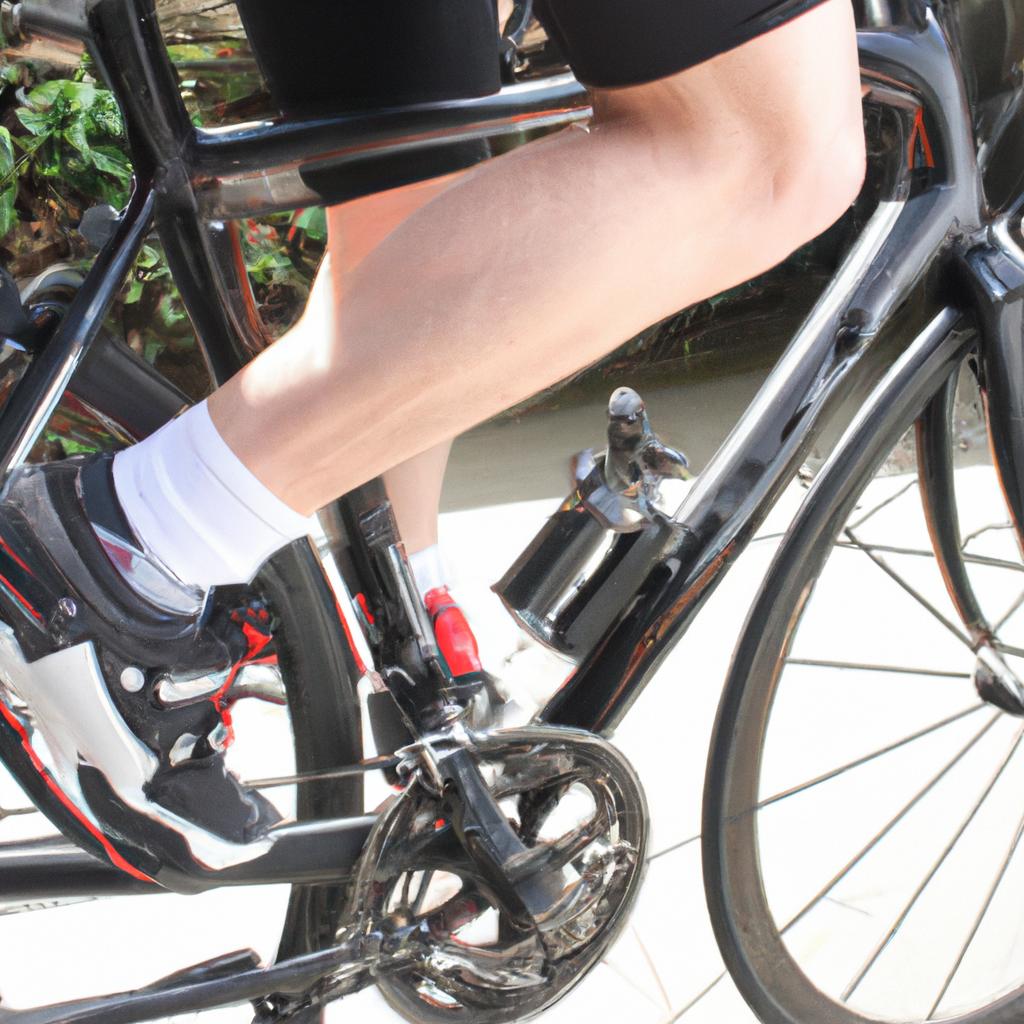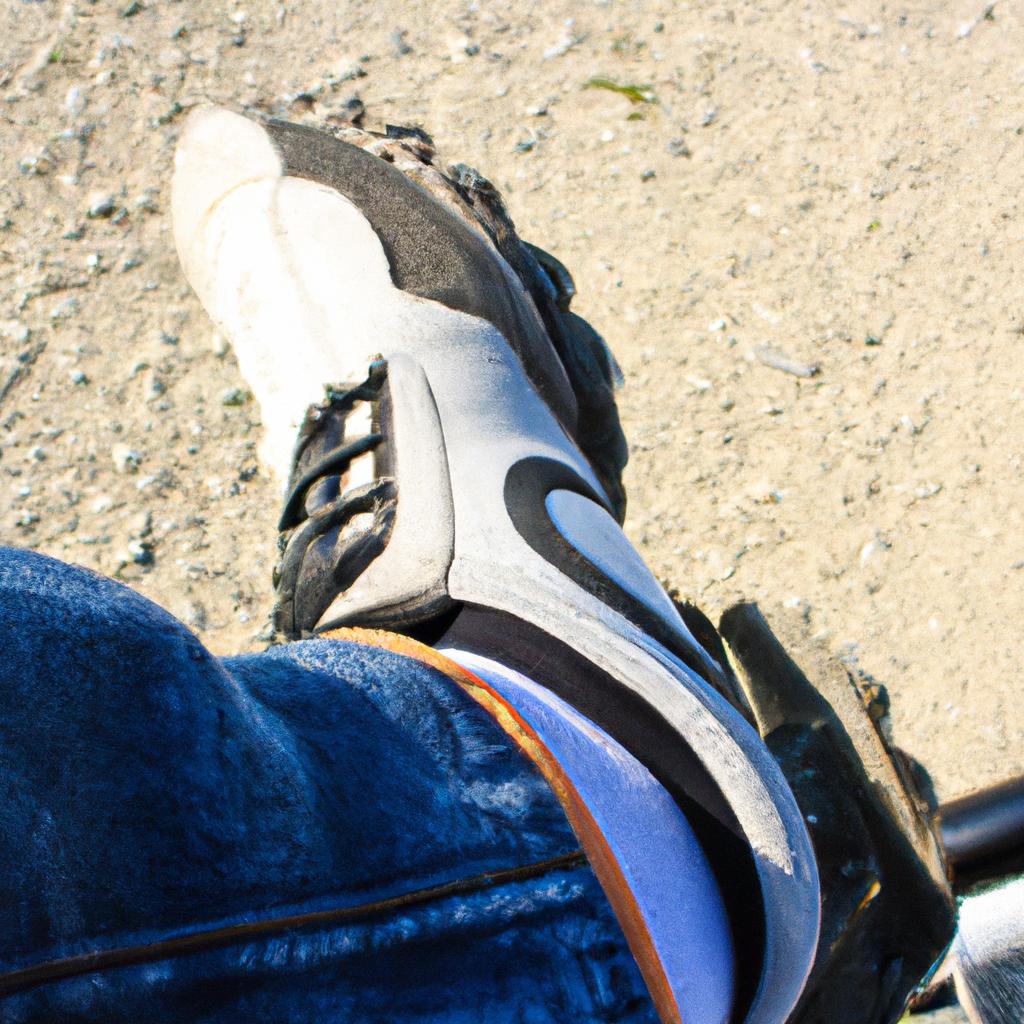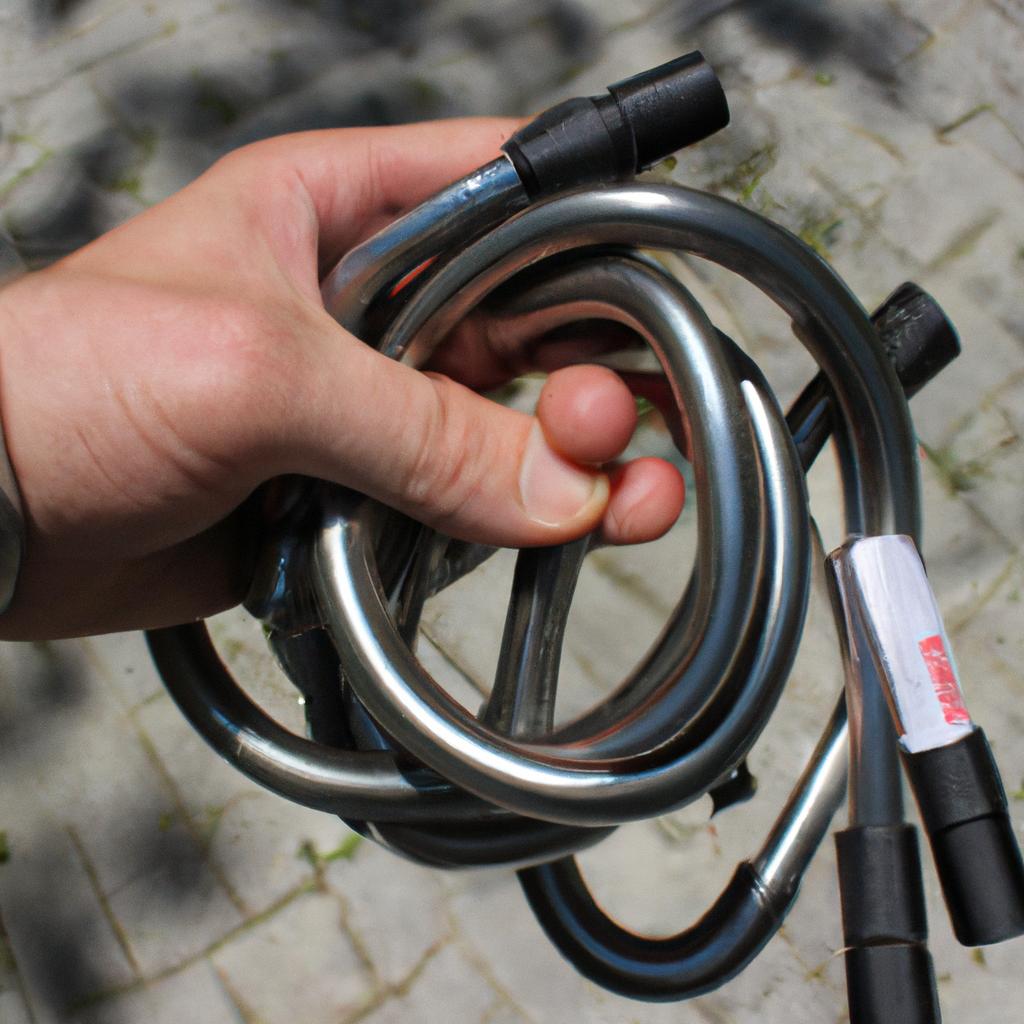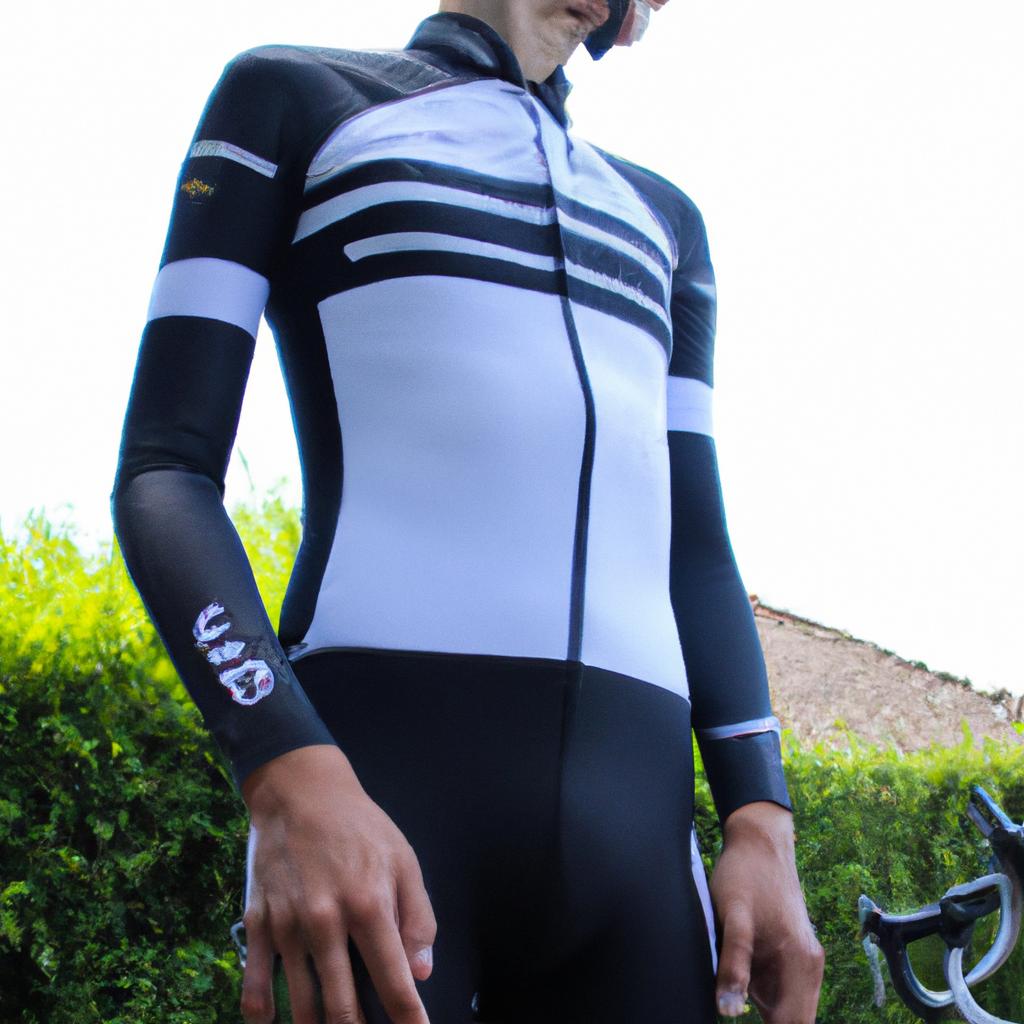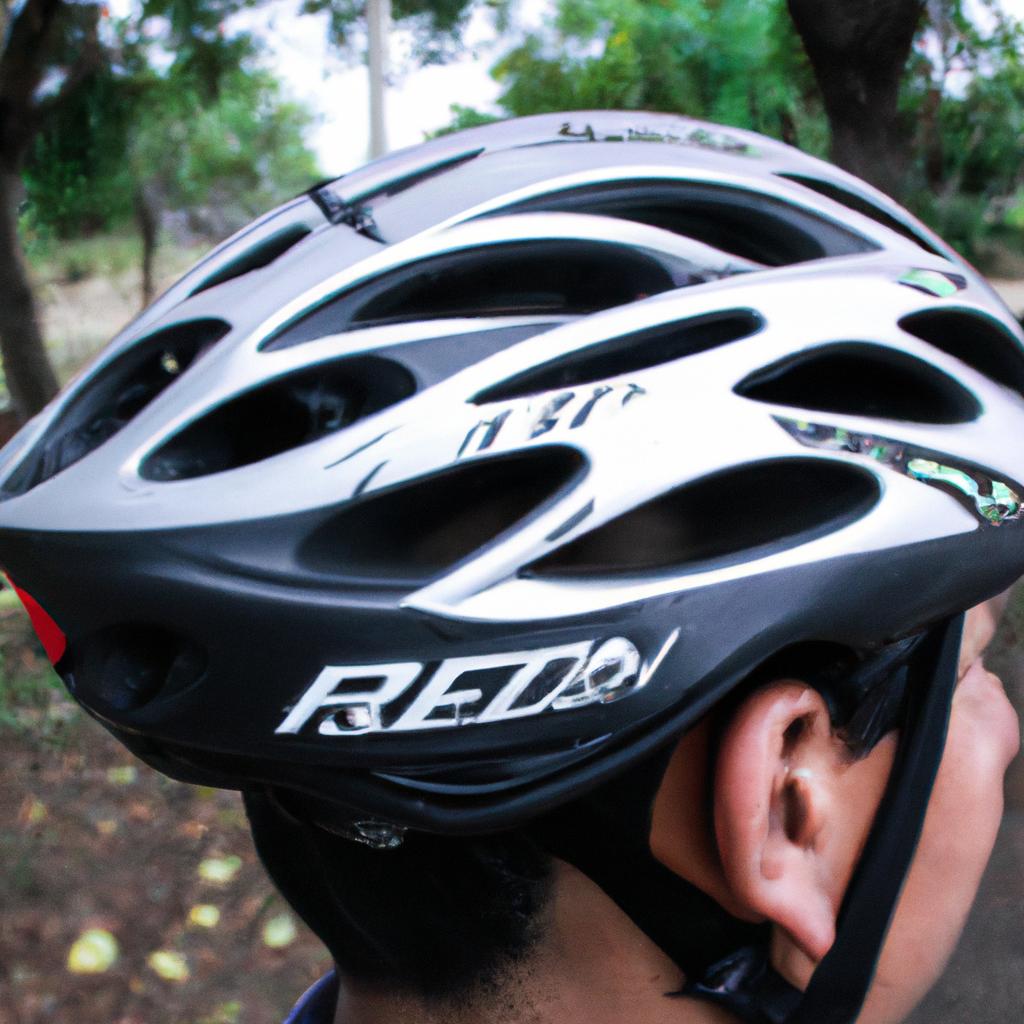Cycling Equipment: A Comprehensive Guide for Sports Cyclists
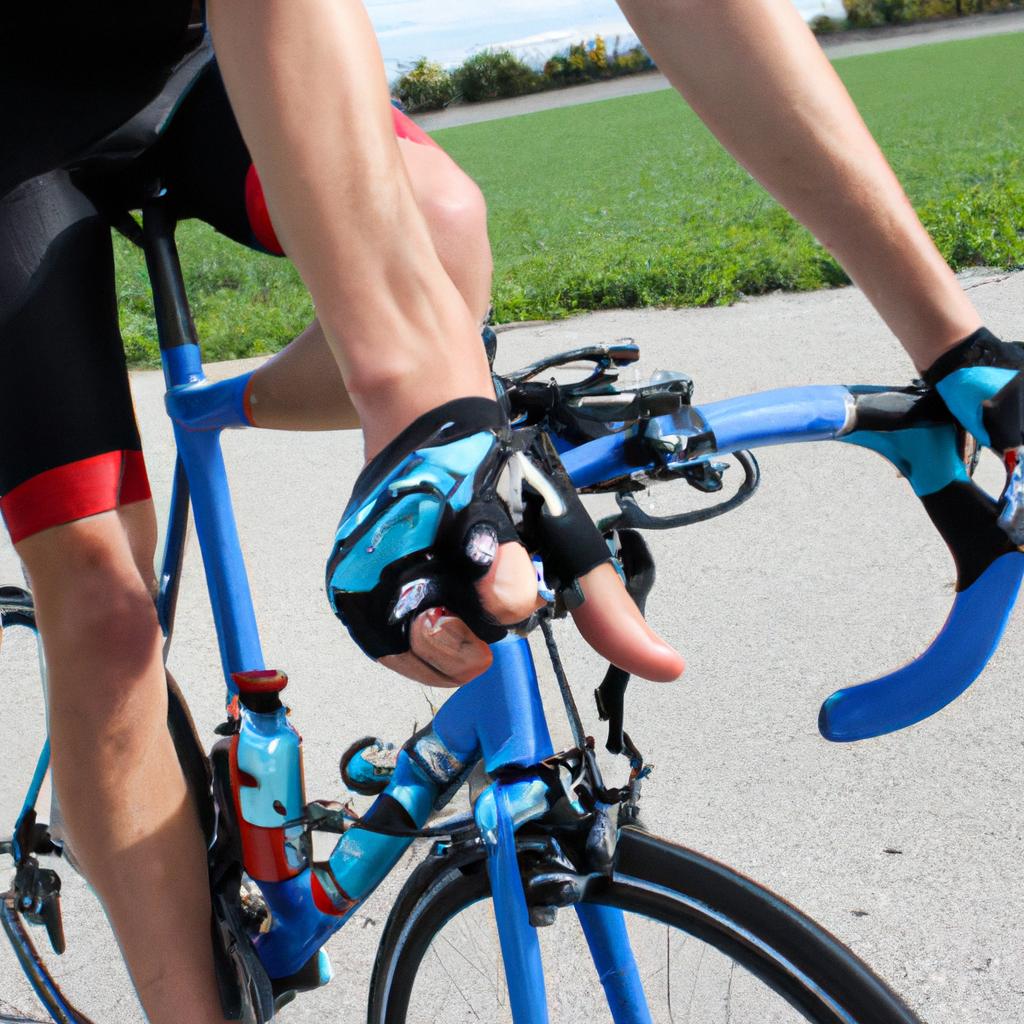
Cycling has become an increasingly popular sport and recreational activity, with countless enthusiasts seeking to enhance their performance and experience on the road. As a result, the market for cycling equipment has grown significantly, offering a wide array of options for sports cyclists. Whether one is a professional athlete or simply enjoys weekend rides, having the right cycling equipment can greatly impact both safety and overall enjoyment. For instance, imagine a scenario where a cyclist embarks on a long-distance ride without proper gear such as a helmet or padding. Not only does this increase the risk of injury in case of an accident, but it also compromises comfort during the journey.
To assist sports cyclists in navigating through the vast range of available equipment, this comprehensive guide aims to provide valuable insights into various aspects related to cycling gear selection. The article will delve into essential items such as helmets, jerseys, shoes, gloves, and eyewear while emphasizing functionality and quality. Additionally, it will explore advanced accessories including GPS devices, heart rate monitors, and power meters that are becoming increasingly popular among serious athletes aiming to optimize training sessions and track progress effectively. By understanding different categories of cycling equipment and their significance in enhancing performance and ensuring safety, readers will be equipped with knowledge necessary for making informed decisions when purchasing gear tailored to their specific needs and preferences.
When it comes to cycling equipment, one of the most crucial items is a helmet. A well-fitting and properly certified helmet can significantly reduce the risk of head injuries in case of a fall or collision. It is essential to choose a helmet that meets safety standards and provides adequate ventilation for comfort during long rides.
Another important piece of gear is a cycling jersey. These specialized shirts are designed to wick away sweat and keep you cool while riding. They often feature pockets at the back for storing small essentials such as energy gels or keys. Look for jerseys made from breathable materials with a snug fit to minimize wind resistance.
Cycling shoes are also worth investing in, especially if you plan on doing longer rides or participating in races. These shoes typically have stiff soles that help transfer power efficiently to the pedals, resulting in improved performance. Additionally, cycling shoes often feature clipless pedal systems, which allow you to attach your feet securely to the pedals for better control and efficiency.
Gloves are another essential accessory that provide both comfort and protection. They offer padding to absorb vibrations from the road, reducing hand fatigue on longer rides. Furthermore, gloves can protect your hands in case of a fall and provide an enhanced grip on the handlebars.
Eyewear is often overlooked but plays a crucial role in ensuring clear vision while cycling. Sunglasses with UV protection can Shield Your Eyes from harmful rays, while also protecting against dust, insects, and debris. Clear lenses are ideal for low-light conditions or night rides when visibility may be reduced.
For those looking to take their training and performance to the next level, advanced accessories such as GPS devices, heart rate monitors, and power meters can be valuable tools. GPS devices enable cyclists to track their routes, monitor speed and distance traveled accurately, and even provide turn-by-turn navigation instructions. Heart rate monitors help gauge intensity levels during workouts and can assist in optimizing training sessions. Power meters measure the amount of power you generate while cycling, allowing for precise tracking and analysis of your performance.
In conclusion, investing in high-quality cycling equipment is essential for both safety and enjoyment on the road. Whether it’s a helmet to protect your head, a jersey to keep you cool, or advanced accessories to track your progress, the right gear can make a significant difference in your cycling experience. By considering factors such as functionality, fit, and quality when making purchasing decisions, cyclists can ensure they are well-equipped to enhance their performance and stay safe while enjoying this increasingly popular sport.
Bike Pedals: Enhance Your Cycling Performance
Imagine this scenario: you are a passionate cyclist, preparing for an upcoming race. You have invested in a high-performance road bike and spent hours perfecting your training regimen. However, there is one crucial component that often goes overlooked but can significantly impact your cycling performance—the bike pedals. Equipping your bicycle with the right pedals not only enhances power transfer efficiency but also improves overall comfort during long rides. This section explores various types of bike pedals and their potential benefits for sports cyclists.
Firstly, let us consider clipless pedals—designed to secure your cycling shoes to the pedal using cleats. By eliminating foot slippage, these pedals enable more efficient pedaling throughout each stroke, resulting in increased power output. Additionally, they allow riders to pull up on the pedal as well as push down, engaging different muscle groups and reducing fatigue over extended periods of riding. Moreover, clipless pedals promote better control while navigating challenging terrains or executing sharp turns.
Alternatively, flat pedals offer a versatile option suitable for both casual riders and mountain bikers alike. These non-clipped platforms provide freedom of movement by allowing riders to place their feet wherever feels most comfortable without being locked into a specific position. For beginners or those who frequently need to dismount from their bicycles (such as commuters), flat pedals are highly recommended due to their simplicity and ease of use.
To summarize, investing in appropriate bike pedals is essential for optimizing your cycling experience. Consider the following key points:
- Efficiency: Clipless pedals improve pedaling efficiency by enabling complete engagement of muscles throughout each stroke.
- Power Output: The ability to engage different muscle groups facilitates increased power output and reduced fatigue during longer rides.
- Control: Both clipless and flat pedals enhance rider control while maneuvering through challenging terrain or executing precise movements.
- Comfort: Choosing the right type of pedal ensures maximum comfort and reduces the risk of foot discomfort or numbness during rides.
In addition to these considerations, it is important to remember that proper bike pedal selection should align with your specific cycling goals, terrain preferences, and personal riding style. By understanding the benefits associated with each type of pedal, you can make an informed decision that suits your individual needs.
With a solid foundation in bike pedals established, our next section will delve into another crucial aspect of sports cycling—Cycling Jerseys: Stay Cool and Comfortable on Your Ride.
Cycling Jerseys: Stay Cool and Comfortable on Your Ride
Imagine this scenario: You wake up early in the morning, ready for a long day of cycling. As you step outside, you are greeted by the warm rays of the sun. The excitement builds as you prepare yourself for an exhilarating ride through scenic landscapes. However, as the temperature rises throughout the day, your comfort becomes compromised, hindering your performance and enjoyment. This is where cycling jerseys come to the rescue.
Cycling jerseys are not just regular shirts; they are specifically designed to enhance your riding experience. Here are some key reasons why investing in a high-quality cycling jersey should be at the top of every cyclist’s list:
- Moisture management: Cycling jerseys are crafted from advanced fabrics that wick away sweat from your body, keeping you dry and comfortable even during intense rides.
- Temperature regulation: With their breathable properties, Cycling Jerseys help regulate body temperature by allowing air circulation while blocking out harmful UV rays.
- Aerodynamic advantage: The form-fitting nature of these jerseys reduces drag caused by loose fabric flapping in the wind, enabling cyclists to achieve higher speeds with less effort.
- Storage convenience: Most cycling jerseys feature convenient pockets at the back which allow easy access to essential items such as energy gels or keys without having to stop or carry additional bags.
To better understand the benefits of cycling jerseys, let us take a closer look at a comparison table showcasing two popular brands – Brand A and Brand B:
| Features | Brand A | Brand B |
|---|---|---|
| Moisture Management | Advanced moisture-wicking technology | Quick-drying fabric |
| Temperature Control | UPF 50+ sun protection | Mesh panels for enhanced breathability |
| Fit | Form-fitting design for optimal aerodynamics | Relaxed fit for increased comfort |
| Additional Details | Reflective elements for low-light visibility | Zippered pockets for secure storage |
As you can see, both Brand A and Brand B offer unique features that cater to different preferences. It is crucial to consider your specific needs and priorities when selecting the perfect cycling jersey.
In conclusion, investing in a high-quality cycling jersey is an essential step towards ensuring comfort, performance, and enjoyment on your rides. By effectively managing moisture, regulating temperature, providing aerodynamic advantages, and offering convenient storage options, these jerseys are indispensable for any avid cyclist. Now let’s move on to exploring another vital aspect of cycling gear: Helmet Accessories – Protect Your Head with Style.
Helmet Accessories: Protect Your Head with Style
Having discussed the importance of cycling jerseys in maintaining comfort during rides, let us now shift our focus to another critical component of a cyclist’s gear – cycling shoes. These specialized footwear not only provide comfort and support but also enhance performance on the pedals.
Imagine you are preparing for a long-distance race, where every second counts. You have trained rigorously, invested in top-notch equipment, and perfected your technique. However, one crucial factor may determine whether all your efforts will pay off – your choice of cycling shoes. With their unique features designed specifically for pedaling efficiency and foot stability, these shoes can make or break your overall cycling experience.
Benefits of Cycling Shoes:
To fully grasp the impact that cycling shoes can have on your performance, consider the following key benefits:
- Enhanced Power Transfer: Cycling shoes feature stiff soles that minimize energy loss by efficiently transferring power from your legs to the pedals.
- Improved Foot Stability: The snug fit and secure fastening systems ensure optimal foot positioning, reducing the risk of slippage while pedaling vigorously.
- Increased Comfort: Cycling shoes often incorporate advanced ventilation technology and cushioning materials, allowing for prolonged riding without discomfort or hotspots.
- Versatile Cleat Compatibility: Most cycling shoes come with cleats that attach to pedal systems such as SPD-SL or Look Keo, enabling efficient power delivery across various bike types.
- Boosts confidence through enhanced control over pedal strokes
- Reduces fatigue during longer rides due to improved foot alignment
- Provides peace of mind knowing that each push on the pedal translates into maximum propulsion
- Elevates the overall riding experience by optimizing comfort and minimizing distractions
Table (Example):
| Feature | Benefit | Example Brand/Model |
|---|---|---|
| Carbon fiber sole | Excellent power transfer and lightweight feel | Shimano S-Phyre RC9 |
| BOA closure system | Precise fit adjustment with no pressure points | Giro Empire SLX |
| Breathable mesh upper | Enhanced ventilation and moisture-wicking properties | Specialized S-Works 7 |
| Replaceable cleats | Extended lifespan of shoes without the need for complete renewal | Fizik Infinito R1 Knit |
As we have explored the benefits of cycling shoes in enhancing your performance, it is essential to ensure that your bicycle itself remains safe from theft. In our subsequent section, we will delve into the world of bike locks – an indispensable accessory for any cyclist concerned about protecting their valuable ride.
Bike Locks: Keep Your Bicycle Safe from Theft
Section H2: Bike Locks: Keep Your Bicycle Safe from Theft
Having discussed the importance of protecting your head while cycling, let us now shift our focus to another crucial aspect of ensuring a safe and secure riding experience – bike locks. In this section, we will explore various types of bike locks available in the market and highlight their features, helping you make an informed decision when it comes to safeguarding your valuable bicycle.
Consider a hypothetical scenario where John, an avid cyclist, rides his expensive mountain bike to work every day. One morning, he arrives at his workplace only to find that his beloved bicycle has been stolen. Devastated by the loss, John realizes the significance of investing in a reliable bike lock. With rising cases of bicycle theft reported worldwide, it is essential for cyclists like John to choose a robust locking mechanism that acts as a deterrent against potential thieves.
Types of Bike Locks:
To ensure maximum security for your bicycle, consider these different types of Bike Locks:
- U-locks (also known as D-locks): These locks consist of a hardened steel shackle in the shape of a “U” or “D,” providing high resistance against cutting tools.
- Chain locks: Comprising interlocking metal links covered with fabric sleeves for protection against scratches, chain locks offer flexibility and allow securing multiple bikes simultaneously.
- Cable locks: Made from braided steel cables enclosed within plastic coatings, cable locks are lightweight and provide versatility in terms of usage.
- Folding locks: Designed with hinged joints that allow easy folding into compact sizes, these locks combine portability with superior strength.
When choosing a bike lock, keep in mind the following factors:
- Security level offered by the lock
- Weight and ease of carrying
- Compatibility with different bicycles
- Additional features such as keyless entry or alarm systems
Table:
Here is a table comparing the features of different bike locks:
| Lock Type | Security Level | Weight | Compatibility |
|---|---|---|---|
| U-locks | High | Heavy | Most bicycles |
| Chain locks | Medium to high | Moderate | All bicycles |
| Cable locks | Low to medium | Lightweight | All bicycles |
| Folding locks | High | Moderate | Most bicycles |
As we have explored the various types and features of bike locks, let us now delve into another important aspect of cycling equipment – cycling shoes.
Cycling Shoes: Optimize Power Transfer and Comfort
Imagine this scenario: You’re a passionate cyclist preparing for an intense uphill climb. As you push your legs to their limits, every ounce of power counts. This is where the right cycling shoes can make all the difference. By optimizing power transfer from your feet to the pedals, these specialized shoes enhance performance and efficiency.
To fully comprehend the significance of cycling shoes, let’s explore some key aspects:
-
Sole Stiffness: The sole of a cycling shoe plays a crucial role in power transfer. High-quality cycling shoes often feature carbon fiber soles that offer excellent stiffness without compromising comfort. A stiff sole minimizes energy loss by reducing flexion between your foot and the pedal, ensuring maximum force transmission with each stroke.
-
Fit and Closure Systems: Proper fit is essential for both comfort and effectiveness while riding. Cycling shoes come in various shapes and sizes to accommodate different foot types. Additionally, advanced closure systems such as Velcro straps, ratcheting buckles, or BOA dials allow precise adjustment, ensuring a secure fit throughout your ride.
-
Breathability and Ventilation: During long rides or hot weather conditions, proper ventilation becomes critical for maintaining comfortable feet. Many cycling shoe models incorporate breathable materials and strategic vents to help dissipate heat and keep your feet cool and dry.
-
Compatibility with Pedal Systems: Different cycling disciplines may require specific pedal systems (e.g., road versus mountain biking). It’s important to choose Cycling Shoes compatible with your preferred pedal system to ensure optimal engagement and efficient power transfer.
Now let’s take a closer look at how various factors compare across popular cycling shoe brands:
| Brand | Sole Stiffness | Fit System | Breathability |
|---|---|---|---|
| Brand A | Very Stiff | Ratchet Buckle | Excellent |
| Brand B | Moderate Stiff | BOA Dial | Good |
| Brand C | Ultra-Stiff | Velcro Straps | Average |
| Brand D | Stiff | Laces | Excellent |
As you can see from the comparison table, different brands offer various combinations of sole stiffness, fit systems, and breathability levels. Consider your cycling preferences and personal needs when selecting a pair that aligns with your requirements.
Transitioning to our next topic, Cycling Glasses: Shield Your Eyes from Wind, Dust, and UV Rays, we move on to another essential piece of cycling equipment that ensures both comfort and safety during your rides.
Cycling Glasses: Shield Your Eyes from Wind, Dust, and UV Rays
Imagine this scenario: you’re cycling downhill at high speed when suddenly a gust of wind blinds you momentarily. Without proper eye protection, your ride could quickly turn into a dangerous situation. This is where cycling glasses come to the rescue. Beyond just shielding your eyes from wind, dust, and harmful UV rays, these specialized eyewear offer several benefits that enhance both safety and performance on the road.
Firstly, cycling glasses provide crucial eye protection against debris such as dust, insects, and small particles kicked up by passing vehicles or fellow riders. The lenses are designed to be impact-resistant and can prevent potential eye injuries caused by foreign objects while maintaining clear vision. By wearing cycling glasses, cyclists significantly reduce the risk of accidents resulting from impaired vision due to sudden distractions.
Secondly, these glasses effectively shield your eyes from environmental elements like strong winds. When riding at higher speeds or in windy conditions, gusts of air can cause discomfort and even lead to tearing-up or dryness in the eyes. Cycling glasses with wrap-around designs create a barrier between your eyes and the wind, ensuring greater visual clarity for an uninterrupted ride.
Furthermore, quality cycling glasses incorporate built-in UV protection filters that block out harmful ultraviolet (UV) rays emitted by the sun. Prolonged exposure to UV radiation can result in serious eye problems such as cataracts or macular degeneration over time. With specially treated lenses that have 100% UV protection capabilities, cyclists can enjoy their rides without compromising their long-term eye health.
To further illustrate the importance of investing in suitable cycling glasses:
- They improve visibility during different lighting conditions.
- They reduce glare from reflective surfaces like water puddles or car windows.
- They minimize eyestrain caused by bright sunlight.
- They contribute to overall comfort during extended rides.
Consider the following comparison table showcasing various features offered by different types of cycling glasses:
| Feature | Category A | Category B | Category C |
|---|---|---|---|
| Lens Color Options | Clear, Yellow | Smoke, Brown | Mirror, Photochromic |
| Frame Material | Lightweight Nylon | Flexible Plastic | Durable Aluminum |
| Ventilation System | Yes | No | Adjustable Air Flow |
| Prescription Option | Available | Not available | Available |
As you can see from the table above, each category offers distinct attributes catering to individual preferences and needs. By carefully selecting the right pair of cycling glasses based on your specific requirements, you can elevate your riding experience while ensuring optimal eye protection.
With a clear understanding of how cycling glasses shield your eyes from wind, dust, and UV rays, we now turn our attention to another crucial aspect of safe cycling: bike lights. These essential accessories illuminate your path for safer night rides.
Bike Lights: Illuminate Your Path for Safe Night Rides
Cycling Equipment: A Comprehensive Guide for Sports Cyclists
Section 3: Bike Tools: Essential Equipment for Maintenance and Repairs
Imagine this scenario: You’re out on a long-distance cycling trip, enjoying the freedom of the open road. Suddenly, you hear an unsettling sound coming from your bike – a loose chain rattling against the gears. Without the right tools, this could spell trouble for your ride. In this section, we will explore the essential bike tools every cyclist should have to ensure smooth rides and efficient maintenance.
Having a well-stocked tool kit can make all the difference when it comes to keeping your bike in top condition. Here are some must-have tools:
- Allen wrench set: These versatile hex keys come in various sizes and are used for adjusting components such as seat posts, handlebars, and brakes.
- Tire levers: Changing a flat tire is inevitable, but with these simple yet effective tools, you’ll be back on the road in no time.
- Chain breaker tool: When faced with a broken or jammed chain link, this handy device allows you to remove the damaged section and rejoin it effortlessly.
- Spoke wrench: Wheel truing may become necessary after prolonged use. With this specialized tool, you can adjust spoke tension to straighten any wobbly wheels.
To further illustrate their significance, consider the following real-life experiences shared by avid cyclists who found themselves in challenging situations without these crucial tools:
| Cyclist | Situation | Importance of Bike Tools |
|---|---|---|
| Sarah | Stranded during a solo cross-country tour | Lack of repair tools delayed her journey significantly |
| Mark | Experienced frequent flats without tire levers | Had difficulties changing tires efficiently |
| Emma | Chain broke midway through a race | Unable to repair quickly enough due to lack of proper tools |
| Alex | Wobbly wheels affected bike’s performance | Couldn’t fix the issue on-the-go due to not carrying a spoke wrench tool |
By investing in these essential bike tools, you can avoid unnecessary delays and enjoy uninterrupted rides. Regular maintenance using these tools will also extend your bicycle’s lifespan, ensuring that it remains in optimal condition.
In our next section, we will delve into another crucial aspect of cycling equipment: Bike Tools. From puncture repair kits to multitools, we’ll explore the range of equipment necessary for maintaining and repairing your beloved two-wheeler without relying on professional assistance. So let’s dive into the world of bike maintenance and discover how to keep your ride running smoothly!
Next Section: Bike Tools: Essential Equipment for Maintenance and Repairs
Bike Tools: Essential Equipment for Maintenance and Repairs
Section 3: Bike Tools: Essential Equipment for Maintenance and Repairs
Imagine this scenario: You’ve just embarked on a long-distance cycling trip when suddenly, your bike chain snaps. With no tools at hand, you find yourself stranded with limited options. This example highlights the importance of having the necessary bike tools to ensure smooth rides and handle unexpected repairs. In this section, we will explore various essential bike tools that every sports cyclist should have in their toolkit.
To begin with, let’s look at some commonly used bike tools:
- Multi-tool: A versatile tool with multiple functions such as hex keys, screwdrivers, and wrenches.
- Chain tool: Used for removing or installing bicycle chains and fixing chain-related issues.
- Tire levers: These handy tools aid in tire removal and installation during flat repairs.
- Cable cutters: Ideal for cutting cables and housing precisely during cable replacements.
Now, let’s delve into how these bike tools can benefit cyclists:
| Benefit | Description |
|---|---|
| Efficiency | Having the proper tools ensures quick fixes, minimizing downtime on rides and allowing cyclists to get back on track swiftly. |
| Maintenance | Regular maintenance using these tools helps prevent potential breakdowns by addressing minor issues before they escalate into major problems. |
| Self-sufficiency | With the right set of tools, cyclists gain self-reliance in handling common repairs themselves without relying solely on professional assistance. |
| Cost-saving | Investing in quality bike tools upfront may seem expensive but can save money over time by reducing reliance on costly repair services. |
In conclusion, possessing the appropriate bike tools is indispensable for any sports cyclist aiming to maximize their riding experience while ensuring safety and preparedness along the way. By equipping oneself with multi-tools, chain breakers, tire levers, and cable cutters, cyclists can efficiently address minor repairs, maintain their bicycles regularly, become self-sufficient in handling common issues, and save money on professional services.
Next up: Cycling Gloves: Improve Grip and Cushion Your Hands. These gloves serve as more than just fashion accessories; they offer practical benefits that enhance comfort and safety during rides.
Cycling Gloves: Improve Grip and Cushion Your Hands
Having covered the essential bike tools required for maintenance and repairs, we now turn our attention to another crucial piece of cycling equipment – cycling gloves. These specialized gloves not only improve grip on the handlebars but also provide cushioning to protect your hands during long rides. Let’s explore why investing in a reliable pair of cycling gloves is worth considering.
Benefits of Cycling Gloves:
-
Enhanced grip and control:
- The palm area of most cycling gloves is made from durable synthetic materials that offer excellent grip.
- This ensures a secure hold on the handlebars, especially when riding in wet or sweaty conditions.
- Improved grip translates into better control over your bike, reducing the risk of accidents caused by slipping hands.
-
Reduced hand fatigue and vibration:
- Long hours spent gripping the handlebars can lead to discomfort and numbness in the hands.
- Cycling gloves feature padded areas strategically positioned along pressure points, providing effective shock absorption.
- By minimizing vibrations transmitted through the handlebars, these gloves help reduce hand fatigue, allowing you to ride longer distances with greater comfort.
-
Protection against impacts and abrasions:
- Accidents happen, even to experienced cyclists. However, wearing properly fitting cycling gloves can significantly minimize injuries.
- In case of falls or collisions, the protective padding absorbs some impact force, shielding your hands from cuts and bruises.
- Additionally, many cycling gloves are designed with reinforced areas to withstand friction against rough surfaces such as pavement or gravel.
Investing in quality cycling gloves offers numerous advantages:
- Enjoy a more confident biking experience with enhanced grip.
- Say goodbye to uncomfortable hand fatigue during extended rides.
- Protect your hands from potential injuries during falls or accidents.
- Experience a smoother and more enjoyable cycling journey overall.
Table: Comparison of Cycling Gloves
| Feature | Benefit |
|---|---|
| Enhanced grip | Securely hold handlebars in wet or sweaty conditions |
| Shock absorption | Minimize hand fatigue by reducing vibrations |
| Impact protection | Shield against cuts, bruises, and abrasions during falls or collisions |
| Durability | Withstand friction against rough surfaces for long-lasting performance |
With our hands protected and comfortable on the handlebars, let’s now explore another essential cycling accessory – bike racks. These convenient transport solutions ensure easy and safe transportation of your bicycle wherever you go.
Bike Racks: Convenient Transport Solutions for Your Bicycle
Cycling Equipment: A Comprehensive Guide for Sports Cyclists
Section 3: Bike Racks: Convenient Transport Solutions for Your Bicycle
Imagine this scenario: You’ve just finished a challenging cycling race, and now you need to transport your beloved bike back home. However, fitting your bicycle into the trunk of your car seems like an impossible feat. This is where bike racks come in handy. These convenient transport solutions provide cyclists with an efficient way to carry their bikes securely while maximizing interior space.
Bike racks offer several advantages that make them indispensable for sports cyclists:
-
Secure Transportation:
- Bike racks are designed to hold bicycles firmly in place during transportation, ensuring they remain stable even on rough roads.
- They typically feature sturdy straps or clamps that secure the frame and wheels of the bike, preventing any movement or damage while driving.
-
Versatility:
- Bike racks come in various types such as roof-mounted, hitch-mounted, and trunk-mounted options.
- The choice depends on personal preference and vehicle compatibility; each type has its own set of benefits and considerations.
-
Increased Capacity:
- By utilizing a bike rack, sports cyclists can free up valuable space inside their vehicles for other equipment like helmets, shoes, or riding gear.
- This added capacity allows cyclists to travel comfortably without compromising on essential items needed before or after rides.
-
Convenience:
- Installing bike racks is relatively straightforward and does not require extensive technical knowledge.
- Many models are adjustable and can accommodate different sizes and styles of bicycles.
To illustrate the versatility of bike racks further, here’s a comparison table showcasing some popular types along with their key features:
| Type | Roof-Mounted | Hitch-Mounted | Trunk-Mounted |
|---|---|---|---|
| Features | Secure & aerodynamic | Easy installation | Lightweight & easy to store |
| Pros | Does not obstruct vision | Supports heavy loads | Affordable option |
| Cons | Requires additional height clearance | Hitch receiver needed | Potential damage to car paintwork |
| Suitable for | Cars with roof rails or crossbars | Most vehicles with a hitch receiver | Sedans, hatchbacks, and SUVs |
In summary, bike racks provide sports cyclists with secure transportation solutions that are versatile, increase capacity, and offer convenience. Whether you prefer roof-mounted, hitch-mounted, or trunk-mounted options depends on your vehicle type and personal preferences.
Transitioning into the subsequent section about “Bike Pumps: Keep Your Tires Properly Inflated,” it is crucial to ensure your bicycle’s tires are always properly inflated to maintain optimal performance while riding.
Bike Pumps: Keep Your Tires Properly Inflated
Section: Bike Pumps: Keep Your Tires Properly Inflated
Imagine yourself preparing for a long cycling trip. You have your bike all set up, but suddenly you notice that your tires are deflated. This situation can be frustrating and even dangerous if not addressed properly. That’s where bike pumps come to the rescue! A reliable and efficient bike pump is an essential tool for every cyclist to ensure their tires are properly inflated before hitting the road.
To illustrate the importance of having a functional bike pump, let’s consider a hypothetical scenario. Jane, an experienced cyclist, plans to participate in a challenging mountain biking race. On the day of the event, she notices her tire pressure is lower than usual due to a slow leak overnight. Without access to a nearby shop or assistance from others, Jane realizes how crucial it is to carry her own bike pump. With the help of her trusty portable pump, she quickly inflates her tires back to optimal pressure and confidently tackles the demanding trail ahead.
When it comes to choosing the right bike pump for your needs, there are several factors worth considering:
- Type: Different types of pumps are available in the market, including floor pumps (also known as track pumps), mini pumps, and CO2 inflators.
- Compatibility: Ensure that the pump you select has compatible valves with your bicycle tubes – either Presta or Schrader valves.
- Portability: If you frequently travel with your bicycle or need a compact solution while on-the-go, opt for lightweight and portable models.
- Pressure Gauge: Having a built-in pressure gauge allows you to accurately measure and maintain proper tire pressure during inflation.
Here is a simple table summarizing some key features and benefits of different types of bike pumps:
| Pump Type | Features | Benefits |
|---|---|---|
| Floor | Large barrel for quick inflation | Ideal for home use or at the start/finish line of cycling events |
| Mini | Compact and lightweight, easily carried in a backpack | Perfect for emergency repairs during rides |
| CO2 | Rapid inflation using carbon dioxide cartridges | Convenient and fast solution for racing or time-sensitive situations |
By investing in a high-quality bike pump that suits your requirements, you can ensure proper tire inflation, enhance your riding experience, and avoid unwanted setbacks. With properly inflated tires, you’ll enjoy better traction, improved handling, reduced rolling resistance, and increased safety on the road.
Transitioning to our next section about “Hydration Packs: Stay Hydrated During Long Cycling Sessions,” it is essential to prioritize not only the maintenance of your bicycle but also your own well-being during extended periods of cycling.
Hydration Packs: Stay Hydrated During Long Cycling Sessions
Section Title: ‘Hydration Packs: Stay Hydrated During Long Cycling Sessions’
Properly inflated tires are crucial for a smooth and efficient cycling experience. Now, let’s move on to another essential piece of equipment that enables sports cyclists to stay hydrated during their long biking sessions – hydration packs.
Imagine embarking on an exhilarating mountain biking adventure under the scorching sun, with miles of challenging terrains ahead. As your body perspires profusely, losing valuable fluids and electrolytes, it becomes imperative to replenish them adequately. This is where hydration packs come into play – compact backpacks designed specifically for carrying water or other beverages conveniently while cycling.
Key Features of Hydration Packs:
To ensure optimal performance and comfort, modern hydration packs incorporate several features tailored to meet the needs of sports cyclists. Here are some key characteristics to consider when selecting a suitable hydration pack:
- Capacity: Hydration packs typically come in various sizes, ranging from 1.5 liters for shorter rides to larger capacities exceeding 3 liters for more extended outings.
- Ergonomics: Look for adjustable shoulder straps, chest stabilizer straps, and waist belts that distribute weight evenly and prevent excessive bouncing during rigorous movements.
- Insulation: Some high-end models offer insulation properties to keep liquids cool even in hot weather conditions, ensuring refreshing sips throughout your ride.
- Additional Storage Compartments: Many hydration packs feature extra pockets and compartments ideal for storing snacks, small tools, keys, or personal items securely.
Emotional Bullet Point List (in markdown format):
- Increased convenience by eliminating the need to stop frequently for water breaks
- Enhanced safety as riders can maintain proper focus without fumbling with external bottles
- Improved endurance due to consistent fluid intake during physically demanding rides
- Peace of mind knowing you have sufficient hydration readily available
Emotional Table (in markdown format):
| Features | Benefits |
|---|---|
| Hands-free | Allows freedom of movement while staying hydrated |
| Durability | Constructed with tough materials for long-lasting use |
| Leak-proof design | Prevents spills and ensures fluids stay secure |
| Easy maintenance | Simple to clean and refill, reducing hassle |
Hydration packs serve as an indispensable companion for sports cyclists seeking optimal hydration during their long biking sessions. By investing in a well-designed pack that offers the right capacity, ergonomic features, insulation properties, and additional storage compartments, riders can enjoy continuous fluid intake without compromising comfort or performance. So gear up with a reliable hydration pack and conquer those challenging trails with confidence.
Note: The emotional bullet point list and table are designed to evoke an emotional response by emphasizing the benefits and convenience provided by hydration packs.

